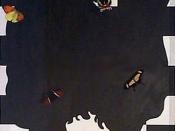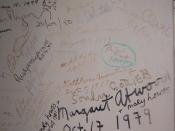Now You See Me, Now You Don't
Illusion is often mistaken for reality. Poet Margaret Atwood's poems, "This is a Photograph of Me" and "Morning in the Burned House" can be compared in terms of writing style, and theme. In "This is a Photograph of Me" Atwood writes using a combination of contrasting, irony, and symbolism, while in the poem "Morning in the Burned House" she uses irony, and symbolism in order to enhance the writing style and the exploration of the line dividing illusion and reality.
Atwood uses many descriptive words near the beginning of the poem to describe the scenery in order to create a calm, peaceful mood. Consequently, just as the reader becomes comfortable with the setting and mood they experience a sudden shift in mood near the end, revealing a dead body lying beneath the surface of the lake. The use of contrasting effectively portrays the dead body in the lake by suddenly shifting the reader's emotion, but, more importantly, it effectively demonstrates the theme illusion versus reality because contrasting is used to show or emphasize differences between the two.
Atwood has incorporated many examples of irony into this poem even in the title. Ironically, the title of the poem is "This is a Photograph of Me" however, the photograph is not of her, it is merely a photograph of a beautiful landscape. The poet writes, "I am in the lake, in the centre of the picture, just under the surface," which is ironic because although the narrator is in the photo she is concealed under the lake difficult to be seen which also contributes to the theme because if one were to look at this photo they must look closely at the lake to notice the dead body, even then...


